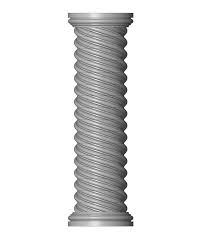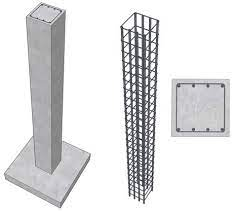A vertical portion with an effective length is three times the vertical member’s length. A column is a structure capable of sustaining compressive stresses with the minimum lateral dimension. From beams or slabs to footings or foundations, columns carry loads. In the case of frames and trusses, struts are slanted members that carry compressive loads. The pedestal is a vertical compression part less than three times the column’s length in effective length. Its lateral dimension is the smallest.
Columns carry axial loads; hence they are intended for compression. The columns can bend due to additional factors such as snow, wind, or other horizontal forces. The columns were designed to handle Axial Load and Bending.
Spiral Column:
Spiral Columns are normally cylindrical with continuous spiral bars wrapped around them. The spiral column’s helical reinforcement, also known as spiral reinforcement, is another name for the reinforcement employed in the spinal column. Spiral reinforcement helps to provide transverse support. In the case of a spiral column, the spiral restricts the concrete’s lateral expansion. Spiral columns are employed where flexibility is necessary or increased strength is cost-effective due to high loads.

Fig 1: Spiral Column
Courtesy: forums.autodesk.com
Spiral columns use spirals to retain the primary longitudinal reinforcement in place and increase the flexibility of the column before it fails. Significant yielding is present in the spiral columns, followed by deformation before ultimate failure. Spiral columns give you a warning before they fail, allowing you to take preventative action.
A type of column is a spiral brick column. Skilled craftsmanship was required for spiral brick columns. Spiral brick columns enhance the structures’ beauty. Spiral brick columns are now frequently utilized in gardens, as verandah opening columns in homes, and other ornamental purposes. The spiral brick column comprises four square bricks arranged in a spiral design.
A minimum of six reinforcement bars uses in a spiral column. The diameter of the spiral column bar should not be less than 12 mm, and the distance between longitudinal bars should not exceed 300 mm. A spirally reinforced column has transverse reinforcement in the shape of spiral hoops. A tightly packed continuous spiral organizes the longitudinal reinforcement bars of the spiral column. Spiral columns are usually circular. Spiral reinforcement should be kept perpendicular to the line and firmly in place.
Tied Column:
A tied column is one in which smaller diameter transverse bars, commonly known as ties, attach the reinforcing bars at regular intervals. The major purpose of the ties is to maintain the longitudinal bars vertical while they are built. It also contributes to the column’s buckling resistance. When a tied column fails, the concrete crushes and shears outward. The longitudinal steel bars buckle outward between the ties, causing the column to collapse unexpectedly. A tied column is used when the reinforcement is in type. Steel ties are used in tied columns to keep the main longitudinal bars of the columns stable. Ties are usually evenly spaced along with the column’s height.

Fig 2: Tied Column
Courtesy: structurepoint.org
Every corner and adjacent longitudinal bar should receive lateral support from the corner of the ties. The top tier should be within 75 mm of the lowest horizontal Reinforcement where the beams are all bracketed, and there is concrete confinement at the top of the column on all four sides.
The following conditions must be followed when using tied reinforcement for compression members: The ties must be half tie spacing above the floor for footing and half tie spacing below the slab’s lowest horizontal reinforcement, just like a tied column. The primary structural members utilized to limit the masonry wall and boost its horizontal and vertical load-bearing capability are tied columns.
Tied brick columns are used in construction because of their architectural attractiveness—this column type is fit for corner pillars, porch columns, boundary gate pillars, and other constructions. The side brick column is easy to build, quick, and inexpensive.
Difference between Spiral Column and Tied Column:
- Spiral reinforcement has a higher load-bearing capability than tied reinforcement, whereas tied reinforcement has a lower load-bearing capability than spiral reinforcement. Spiral reinforcement is more malleable and flexible than tied reinforcement.
- Spiral columns are good for building in earthquake-prone locations, while coupled columns are not ideal for construction.
- Before the ultimate failure, the spiral column shows distortion or indication; high loads lead a knotted column to fail quickly.
- A spiral column may endure massive deformations before collapsing; a tied column collapsed suddenly due to substantial cracking in the concrete part.
- In a spiral column, ties give lateral support; in a tied column, helicoidally hoops provide lateral reinforcement.
Conclusion:
Spirally reinforced concrete columns can handle more weight than tied concrete columns with less load eccentricity. Spirally reinforced columns exceed ties-reinforced columns in toughness and flexibility at low load eccentricity. As a result, experts recommend using spiral reinforcement instead of connections in reinforced concrete columns when possible.
References:
1. Spiral Column Vs. Tied Column | What Is Tied Column | What Is Spiral Column – ConstructUpdate.com. (2021, August 23). ConstructUpdate.com. https://www.constructupdate.com/spiral-column-vs-tied-column/.
2. Behavior Of Tied And Spiral Columns. (n.d.). Brainard. https://www.brainkart.com/article/Behavior-of-Tied-and-Spiral-Columns_3737/.
3. M. (2020, July 21). Types Of Column Used In Construction – Civilmint. Civilmint. https://civilmint.com/types-of-column/.
4. WikiEngineer:: Structural:: Concrete Tied Columns. (n.d.). Wiki Engineer:: Structural: Concrete Tied Columns. http://www.wikiengineer.com/Structural/ConcreteTiedColumns.
If you have a query, you can ask a question here.


